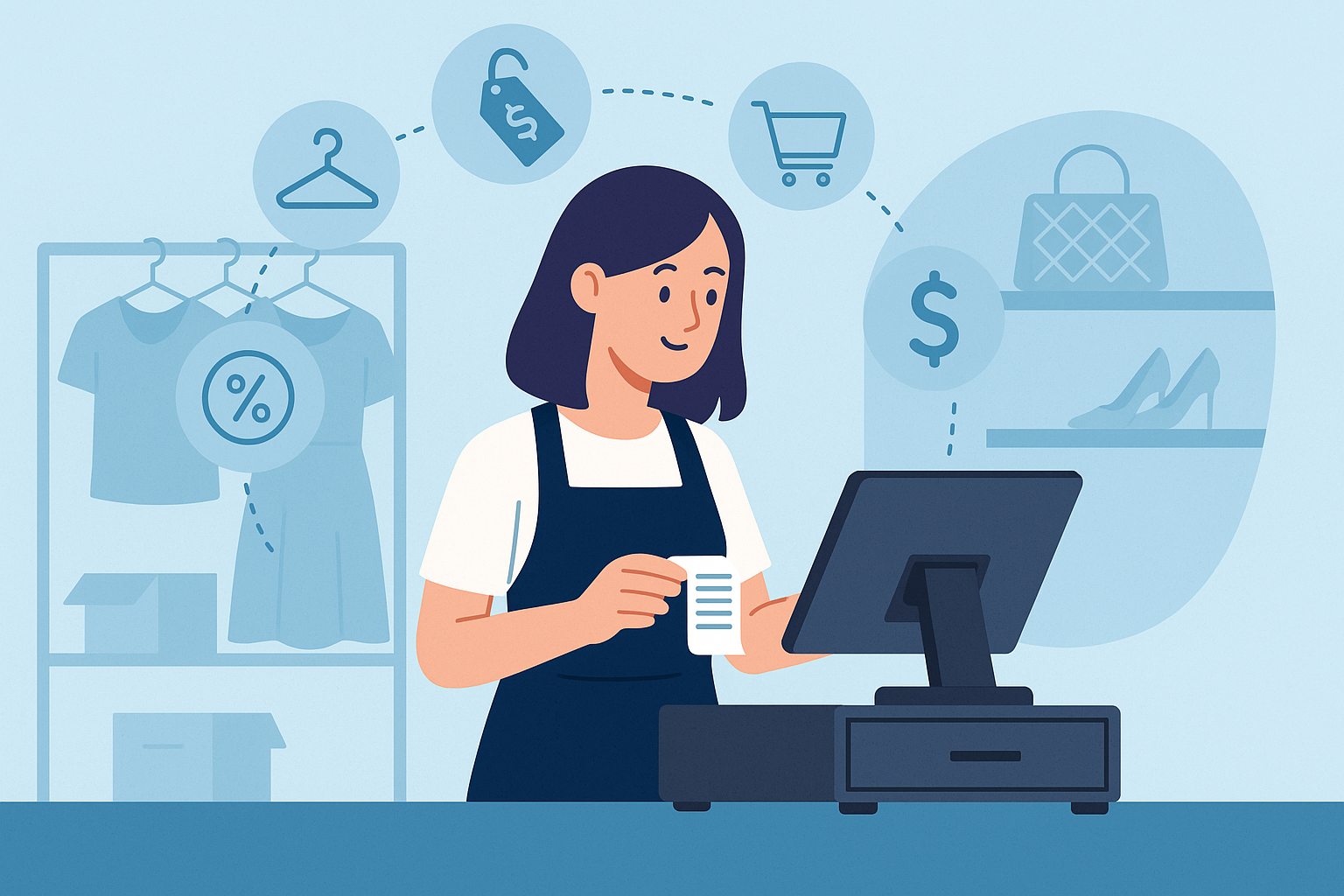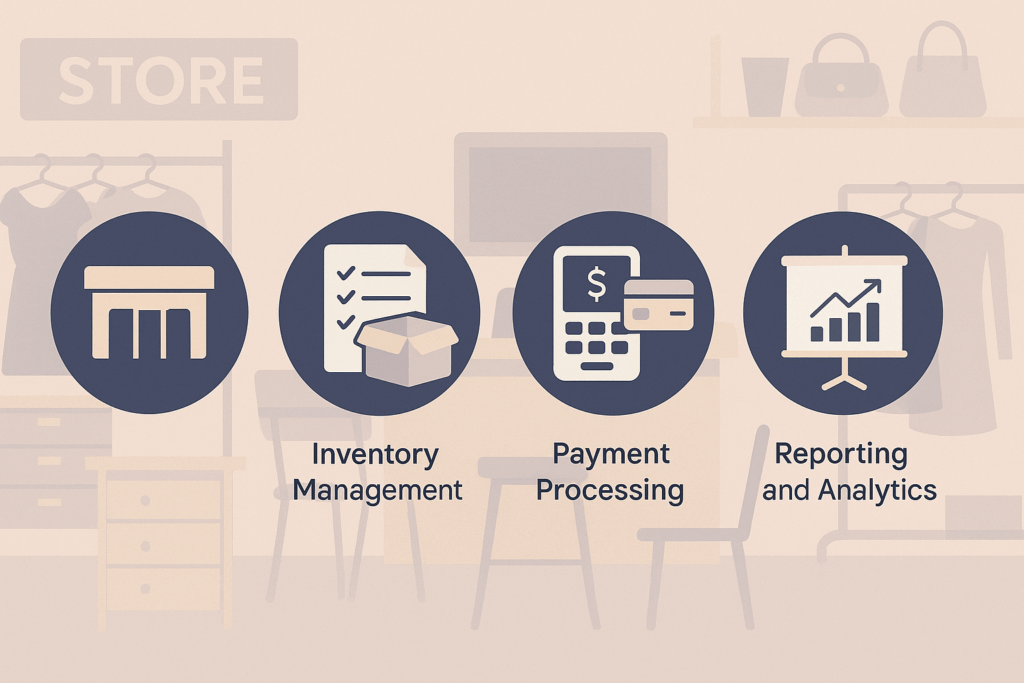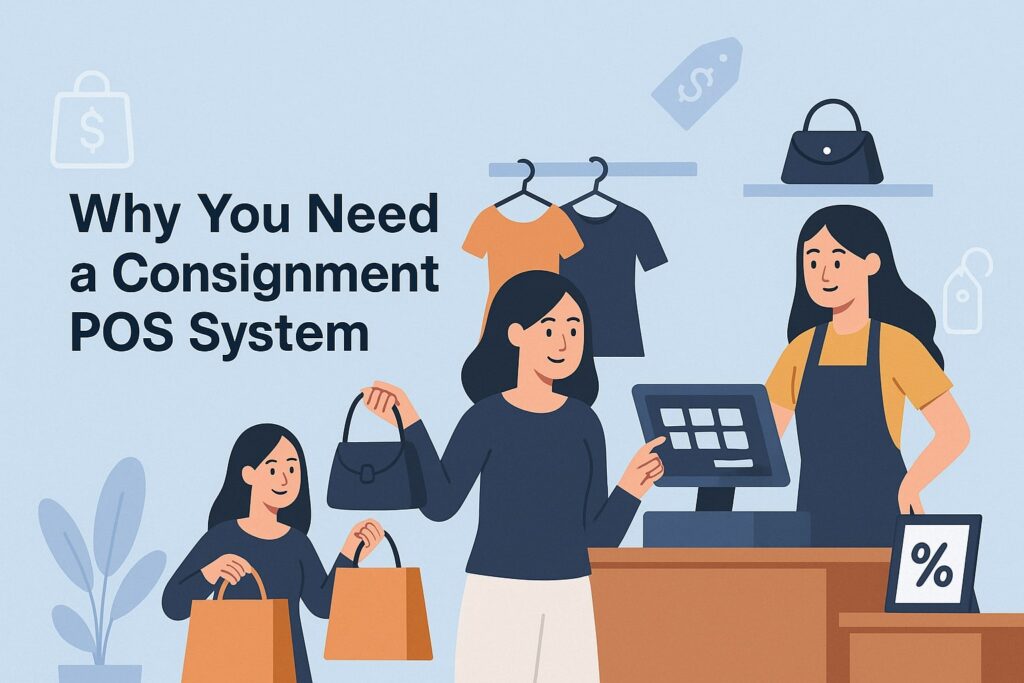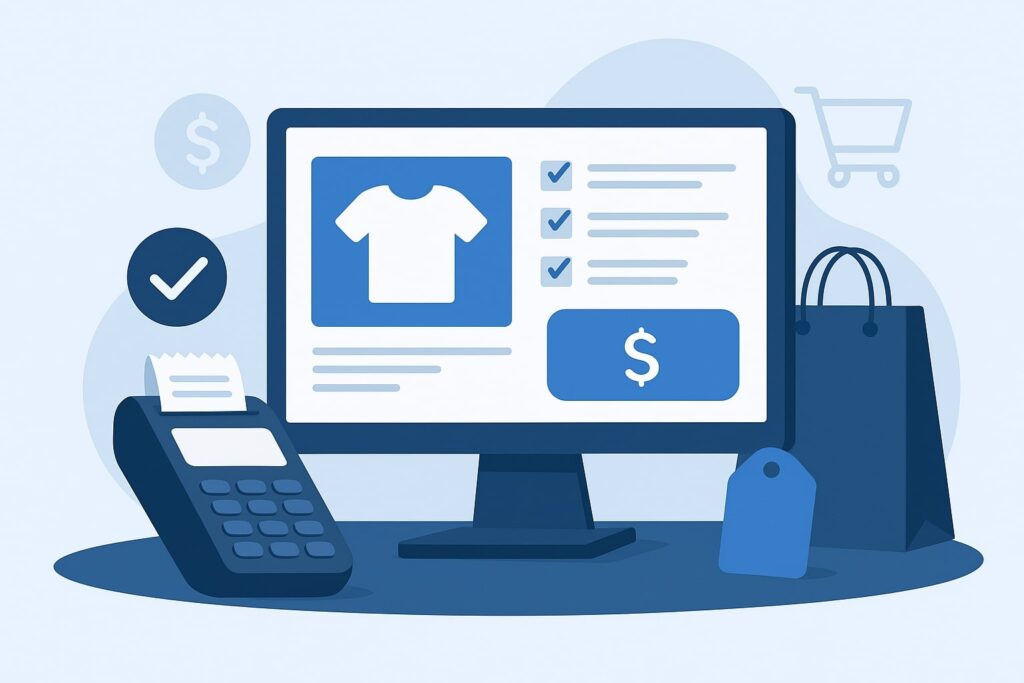
By consignmentpos September 12, 2025
Consignment retail is a business model where a store (consignee) sells items on behalf of their owners (consignors). The store takes a cut of each sale, then pays the consignor the remainder. This means the consignor retains ownership until the item is sold.
Consignment stores often carry an eclectic mix of goods from many sellers. A specialized consignment POS system keeps track of which item belongs to which consignor and calculates each person’s commission.
By linking each sale to a consignor, the POS automates payouts and ensures accuracy. This tailored system also simplifies communication with consignors and scales as inventory grows.
In the U.S., consignment retail is booming. There are tens of thousands of consignment and resale shops nationwide, growing at about 7% per year. The second-hand market is expected to reach around $70 billion by 2027.
With this growth, store owners need robust tools to manage complex inventories, schedule markdowns, and keep consignors satisfied. A consignment POS system is designed to meet these needs by automating the unique workflows of resale businesses.
What is a Consignment POS System?
A consignment POS system is a point-of-sale solution built specifically for consignment shops. Unlike a generic cash register, it includes features for tracking consigned inventory and managing consignors.
For example, Best Consignment Shop Software explains that consignment POS is a comprehensive software and hardware solution tailored for consignment stores to handle sales, inventory, and customer transactions.
In practice, this means the system lets you tag each item by its owner, record which consignor to credit when an item sells, and automate those split payments.
Many consignment POS systems are cloud-based, which means they work on tablets or computers and back up data online. Some are all-in-one packages, while others integrate a mainstream POS (like Square or Shopify) with consignment management software.
In either case, the goal is the same: streamline consignment operations. According to Merchant Maverick, consignment software “includes a POS with either built-in consignment features or integrations with third-party consignment apps”.
This combination of general retail features and consignment-specific tools is what sets a consignment POS apart.
Key Features of Consignment POS Systems

Consignment POS solutions pack many features to handle the resale business model. Common features include:
- Inventory Management: Tag and track each item by consignor. Modern systems support barcode scanning and bulk item entry to update stock levels in real time. This prevents overselling unique items and keeps inventory counts accurate.
- Consignor/Vendor Accounts: Maintain a detailed record for every consignor. The POS tracks how many items each consignor has in stock, what has sold, and what balance is owed. Most systems automatically calculate commission splits for each sale.
- Automated Payments: Handle consignor payouts electronically. A consignment POS can queue up vendor payments and fees. Some platforms (like ConsignCloud and Ricochet) even integrate with payout services (ACH, checks, or store credit) so stores can pay consignors quickly.
- Flexible Pricing: Support complex pricing rules. For example, set default markup or commission rates by item type, and schedule automatic markdowns for aging inventory. This ensures items gradually discount if they don’t sell, without staff having to manually track dates.
- Point-of-Sale Checkout: Provide a fast, user-friendly register. Consignment POS software often runs on tablets or PCs with customer-facing screens.
Features like quick item lookup, barcode scanners, and mobile checkout speed up sales. Some systems also allow cash sale of items and assignment of “new inventory” on the fly. - Reporting & Analytics: Generate reports tailored to consignors. Owners can pull reports on individual consignor sales, item performance, and overall profit after commissions.
These insights help you see top-selling items or consignors, track average time-to-sale, and make data-driven decisions about pricing and inventory. - Customer Management: Track customers who buy consignment items. Many consignment POS include CRM features or loyalty programs, so you can build repeat business. You can also sell items via e-commerce if supported (for example, syncing with Shopify or other marketplaces).
- Integrations: Link with other tools. Common integrations include accounting software (QuickBooks, Xero) and e-commerce (Shopify, WooCommerce).
This lets you sync sales, inventory, and financial data across systems. Some consignment POS (like Epos Now or SimpleConsign) also have vendor mall modules for multi-vendor stores.
Why You Need a Consignment POS System

Operating a consignment or resale store without a dedicated POS can be extremely challenging. A specialized consignment POS system solves many pain points that plague manual processes. Key benefits include:
- Error-Free Inventory: Consignment POS automates tagging and tracking of hundreds of unique items. This eliminates lost tags, prevents overselling, and keeps your stock data accurate across one or multiple locations.
- Accurate Commissions: The system links each sale to the correct consignor and automatically calculates their share. This avoids math mistakes and builds trust, since consignors can see exactly what they earned. It eliminates manual spreadsheets and simplifies periodic payouts.
- Speed and Efficiency: Barcode scanners and digital forms make check-in and checkout fast. Instead of hand-keying prices or writing tickets, staff scan items and the POS fills in details. Faster transactions mean shorter lines and happier customers, while staff spend less time on paperwork.
- Automated Pricing: You can set up markdown schedules so prices drop automatically over time. This ensures older items get discounted without having to remember each tag. It helps clear slow-moving stock and maximizes your sales.
- Insights and Reporting: Built-in reports reveal what’s selling well and what isn’t. For example, you can identify your top consignors or high-margin categories. Data-driven reports help you stock the right mix of items and adjust strategies to boost profits.
- Scalable Operations: A cloud-based consignment POS lets you add locations or sales channels with ease. Inventory is synced across stores and online. You’ll avoid selling the same item twice, and managers can access sales data anywhere. This is crucial if you expand or start selling online in addition to your physical store.
In short, a consignment POS frees you from the bottlenecks of manual systems. It reduces errors, saves hours of work each week, and keeps consignors happy with timely, accurate payments. Many consignment shops cite the POS as a key factor in enabling growth and sustainability.
Popular Consignment POS Software

There are many POS systems that can work for consignment shops. Some are specialized consignment platforms, while others are general POS systems that support consignment through add-ons or integrations. Below is a comparison of well-known options:
| POS System | Key Strengths | Starting Price |
|---|---|---|
| Square POS | Free plan; widely used; integrates with Rose (consignment app). Easy to set up and runs on tablets or phones. | $0/mo (free plan) |
| Lightspeed Retail | Built-in consignment features; powerful inventory tools. Multi-store and omnichannel support. | $109+/mo (basic) |
| Shopify POS | Strong omnichannel (online + in-store) with many apps. Scalable for small to large businesses. | $39+/mo (Basic plan) |
| Clover POS | Intuitive hardware; easy setup. Supports consignment via third-party apps (e.g. Consignment by Zoomifi). | $0–84.95/mo (apps) |
| Ricochet POS | Dedicated consignment POS: iPad and PC compatible. Includes consignor portal, credit accounts, and online consignment sales. | $159/mo |
| ConsignCloud | Cloud consignment software. Free basic plan tracks unlimited consignors and inventory. Offers consignor portal and integrated payouts (Checkbook.io). | $0 (basic plan) |
Each option serves different needs. Square is budget-friendly and familiar to many small retailers, but relies on a consignment app (Rose) for consignor tracking. Lightspeed has native consignment tools and excellent inventory features, but requires a monthly subscription and its own payment processor.
Shopify shines if you want to sell both online and in-store, and it can integrate with apps like Vendor Consignment or Aravenda for consignment support. Clover offers sleek hardware and easy setup; you can add consignment functionality via Clover apps.
On the consignment-specific side, Ricochet is built exclusively for consignment shops, with features like consignor logins, detailed reports, and even a mobile POS option.
ConsignCloud is attractive for shops on a tight budget: it offers a free tier with unlimited consignor and inventory tracking. It includes consignor management and syncs with payments for payouts, though advanced features cost extra.
Other specialized platforms (not shown in the table) include ConsignPro, SimpleConsign, ResaleWorld, and Rain, each with unique strengths like vendor mall management or repair order support.
When choosing a system, consider factors like your store size, budget, and whether you need online sales. Many consignment shops use a hybrid approach: for example, using Square or Shopify for checkout and a connected consignment management app on the backend.
As one expert guide notes, combining a general POS with consignment inventory software lets you “get the best of both worlds”: modern checkout features plus dedicated consignment workflows.
Frequently Asked Questions
Q.1: What does a consignment POS do differently?
Answer: Unlike a regular POS, a consignment POS tracks each item’s owner and handles profit-sharing. It automates consignor accounts, commissions, and payouts. In other words, it manages inventory the way a consignment store needs, not just general retail.
Q.2: Can I use my regular POS (e.g. Square or Shopify) for consignment?
Answer: Yes, but with workarounds. Generic POS systems like Square or Shopify handle sales and payments, but don’t natively link sales to consignors.
To fully manage consignment, you would add a consignment management app (such as Rose for Square, or ConsignCloud) that tracks which consignor each sale goes to. At some point, growing stores often switch to a dedicated consignment system to avoid manual work.
Q.3: What features should a consignment POS have?
Answer: At a minimum, look for consignment-specific features: inventory tagging by consignor, automatic commission splits, consignor account balances, and payout tools.
Other key features include barcode scanning, sales reporting by consignor, and a consignor-facing portal or statement generator. Integration with bookkeeping or e-commerce is also very helpful for streamlining operations.
Q.4: How much does a consignment POS cost?
Answer: Pricing varies widely. Some solutions (like Square or Shopify) have free entry-level plans but require paid add-ons for consignment features. Dedicated consignment POS systems typically charge a monthly fee.
For example, Ricochet charges around $159/month, while ConsignCloud’s basic plan is free (with paid upgrades). Always consider transaction fees, hardware costs, and any contract requirements.
Q.5: Does a consignment POS handle online sales too?
Answer: Many modern consignment POS platforms support selling online. For example, Shopify POS is inherently multichannel, and several consignment systems have e-commerce integrations.
Square and Lightspeed can also sync with online stores. The advantage of a unified POS is that it updates inventory whether you sell in-store or on a website, preventing overselling.
Conclusion
A consignment POS system is an essential tool for any consignment or resale store owner. By automating inventory tracking, consignor accounting, and payouts, it transforms a complex manual process into a streamlined workflow.
As the consignment market grows (over 7% annual growth in the US), using the right POS can save time, reduce errors, and improve profitability. When choosing a system, focus on your specific needs: do you need an affordable starter solution, or a robust platform with advanced reporting?
Whether you go with a general POS plus consignment app, or a dedicated consignment system like Ricochet or ConsignCloud, the key is that the software works for you and your consignors. With the right consignment POS in place, you can confidently scale your store, serve consignors better, and stay organized in today’s competitive second-hand marketplace.